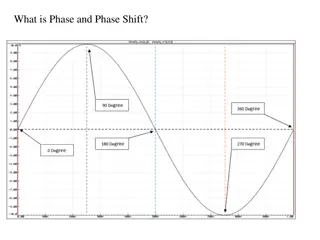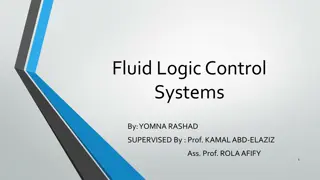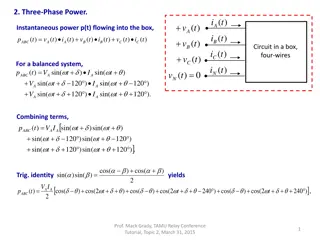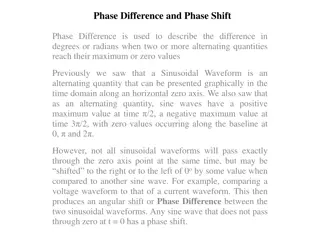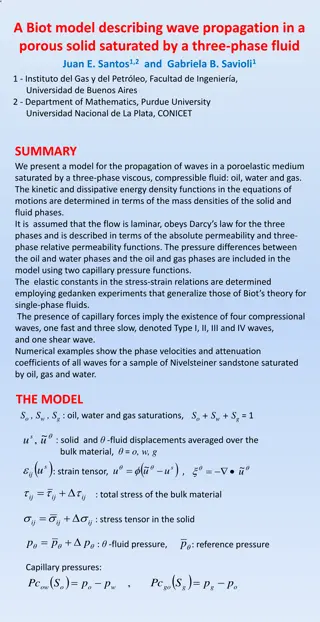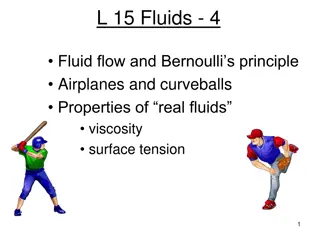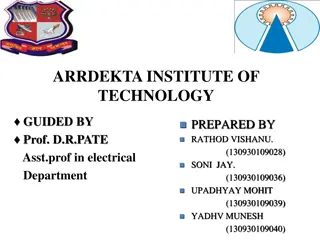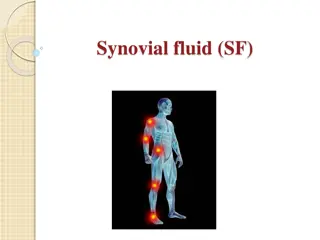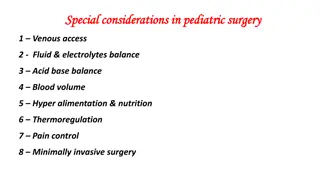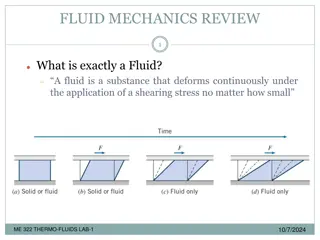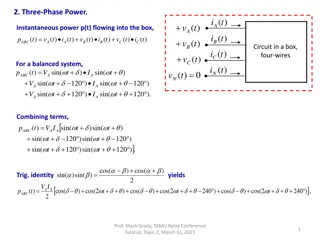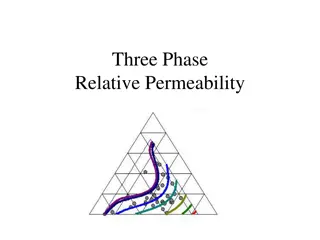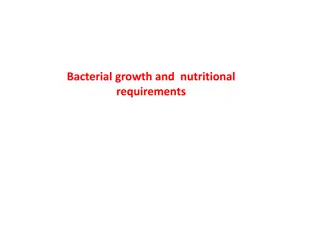Fluid Management in ICU: Understanding Body Fluid Compartments and Types of Fluids
Fluid management in the ICU is crucial for patient care. This includes understanding the distribution of body fluid compartments, such as intravascular, interstitial, and intracellular fluids. Different types of fluids like crystalloids and colloids play essential roles in treatment. Crystalloids ar
3 views • 26 slides
Understanding Fluid Pressure in Oil Field Hydraulics
Explore the fundamentals of fluid pressure including pressure basics, unit conversion, fluid weight constants, true vertical depth, and hydrostatic pressure in the context of oil and gas technology programs. Learn how to calculate pressure gradients, understand the impact of fluid density on pressur
1 views • 40 slides
Understanding Fluid Therapy in Veterinary Medicine
In the nineteenth century, fluid therapy was limited to severely ill patients, but now both veterinary and human medicine utilize intravenous fluid therapy extensively. Dehydration can have serious consequences, and isotonic replacement fluids are essential based on estimated dehydration, maintenanc
1 views • 20 slides
Understanding RC Phase Shift Oscillators
Dive into the world of RC phase shift oscillators, exploring the concepts of phase and phase shift in electronic circuits. Learn how cascading RC networks can achieve specific phase shifts, the role of impedance, and the practical applications of RC feedback networks in oscillator circuits. Discover
1 views • 18 slides
Overview of Fluid Mechanics: Branches, Flow Types, and Equations
Fluid mechanics is subdivided into three branches: Fluid Static, Kinematics, and Hydrodynamics. The study of fluid flow includes different types such as uniform, non-uniform, steady, and unsteady flow. The motion of fluid particles obeys Newton's laws, and the conservation of mass and energy plays a
1 views • 4 slides
Understanding Fluid Machines: Specific Work and Energy Transfer
In Chapter 3 of "Specific Work of Fluid Machines" by Eng. Mesfin B., the focus is on energy transfer and determination of specific work. The chapter covers topics such as energy loss, total pressure, the Bernoulli equation, and more. Learn how to calculate mechanical energy and power transferred by
4 views • 33 slides
Understanding the Three Stages of Project Life Cycle
The project life cycle consists of three key stages: pre-investment phase, construction phase, and normalisation phase. The pre-investment phase involves objective formulation, demand forecasting, and cost-benefit analysis. The construction phase focuses on building project infrastructure and invest
1 views • 5 slides
Introduction to Fluid Logic Control Systems
Fluid logic control systems utilize devices that switch fluid, like air, between outlets, providing ON/OFF outputs swiftly based on control signals. This article explores moving-part logic devices, control functions, Boolean algebra applications in control technology, and advantages of fluid logic s
1 views • 22 slides
Regulation of Extracellular Fluid Volume in Renal Physiology
This lecture focuses on the mechanisms involved in the regulation of extracellular fluid volume, primarily highlighting the role of sensors, effectors, and the kidney in maintaining body fluid balance. It discusses the importance of regulating extracellular fluid volume and osmolarity for controllin
0 views • 25 slides
Understanding Three-Phase Power Systems and Instantaneous Power Flow
This detailed content delves into three-phase power systems, analyzing instantaneous power flow, balanced circuits, and trigonometric calculations. It explores the concept of constant three-phase power and provides insights into the analogy of a piston engine with infinite cylinders. The data includ
2 views • 9 slides
Understanding Phase Equilibria in Physical Pharmacy
Delve into the complexities of states of matter, phase equilibria, and the phase rule as explained by Assistant Prof. Dr. Fouad Al-saady in the context of physical pharmacy. Learn about phase definitions, phases in different systems, and examples illustrating phase differentiation in various substan
0 views • 22 slides
Understanding Non-Dimensional Numbers in Fluid Mechanics
Non-dimensional numbers play a crucial role in understanding fluid motion. This includes Reynolds Number for inertia and viscous forces, Froude Number for gravity effects, Cauchy Number for compressible flows, and Mach Number for elasticity forces. These numbers help in analyzing pipe friction, flow
1 views • 10 slides
Understanding Fluid and Electrolyte Management in Surgical Patients
This article delves into the intricacies of fluid and electrolyte management in surgical patients, covering topics such as total body water distribution, fluid compartments, electrolyte composition, body fluid changes, and disturbances in volume, concentration, and composition. It explores the fluid
0 views • 25 slides
Understanding Fluid Mixing in Chemical Reactions
The problems associated with fluid mixing during reactions are crucial for fast reactions in both homogeneous and heterogeneous systems. These issues involve the degree of segregation of the fluid and the timing of mixing. Concepts like RTD are intertwined with fluid mixing, affecting the behavior o
1 views • 46 slides
Understanding Poly Phase Induction Motor Construction
An induction motor is comprised of a stator and rotor, with the stator featuring a 3-phase winding fed from a 3-phase supply. The rotor comes in two types - squirrel-cage and phase wound. The squirrel-cage rotor consists of heavy bars tightly pressed on the shaft, while the phase wound rotor has a 3
0 views • 47 slides
Understanding Fluid Flows in Fluid Mechanics
Fluid Mechanics is the study of fluids in motion or at rest, and their interactions with solids or other fluids. Fluid flows are classified based on various characteristics such as viscous versus inviscid regions, internal versus external flow, compressible versus incompressible flow, laminar versus
1 views • 16 slides
Marine Corps Expeditionary Fluid Analysis System (EFAS) Overview
The USMC Expeditionary Fluid Analysis System (EFAS) led by Mr. Anton Schager is a deployable, real-time fluid analysis system supporting Condition-Based Maintenance for Marine Corps ground equipment. It consists of two tiers - a ruggedized portable analyzer for tactical units and a benchtop analyzer
4 views • 12 slides
An Overview of High Performance Liquid Chromatography (HPLC)
High Performance Liquid Chromatography (HPLC) is a powerful analytical technique used for separating and identifying compounds in a mixture. It involves a mobile phase and a stationary phase to achieve separation based on different physicochemical properties. The mobile phase plays a crucial role in
0 views • 20 slides
Understanding the Phase Rule in Physical Pharmacy: Two Component Systems and Equilibrium Phases
The Phase Rule is essential in determining the state of a system based on components and phases. This study explores two-component systems in physical pharmacy, illustrating miscibility behaviors and equilibrium phases through diagrams and explanations. Understanding binodal curves, tie lines, and t
0 views • 12 slides
Understanding Phase Difference and Phase Shift in Sinusoidal Waveforms
Phase difference and phase shift describe the angular displacement of sinusoidal waveforms in degrees or radians. These concepts are crucial in analyzing the relationship between alternating quantities such as voltage and current. The phase angle determines the shift of a waveform along the horizont
1 views • 26 slides
Perioperative Fluid Therapy: Key Concepts and Considerations
Understanding perioperative fluid therapy is crucial for maintaining normovolemia, achieving hemodynamic stability, and preventing complications. Factors such as total body water variation, fluid resuscitation goals, desirable outcomes, and fluid and electrolyte regulation play a critical role in en
3 views • 56 slides
Model for Wave Propagation in Poroelastic Medium Saturated by Three-Phase Fluid
We introduce a model describing wave propagation in a porous solid saturated by a three-phase fluid (oil, water, and gas). The model considers kinetic and dissipative energy density functions, laminar flow obeying Darcy's law, and capillary pressure functions. Elastic constants are determined using
1 views • 4 slides
Understanding Fluid Dynamics and Bernoulli's Principle in Real-world Applications
Explore the fascinating world of fluid dynamics with a focus on Bernoulli's principle through real-life examples like air flow in wind tunnels, airplane wings, and even tornado behavior. Discover how changes in fluid velocity affect pressure and how streamlines provide insights into fluid flow behav
1 views • 23 slides
Understanding Three Phase Transformers and Connections in Power Systems
Exploring the fundamentals of three-phase transformers and their connections in power systems, such as star-star, delta-delta, star-delta, and delta-star. Learn about advantages, disadvantages, and applications of these configurations in balanced and unbalanced loads. Discover how three single-phase
0 views • 19 slides
Understanding Synovial Fluid and Its Role in Joint Health
Synovial fluid, also known as joint fluid or synovia, is a plasma dialysate that lubricates joints and allows for smooth movement. It is produced by the synovium and contains important components like hyaluronic acid and lubricin. This fluid reduces friction, provides shock absorption, supplies nutr
0 views • 27 slides
Pediatric Surgery: Special Considerations for Venous Access and Fluid Management
Pediatric surgery requires special attention to venous access and fluid management due to unique considerations in infants and children. Key aspects include methods for obtaining vascular access, monitoring fluid and electrolyte balance, and addressing specific fluid requirements based on age and we
0 views • 15 slides
Understanding Intravenous Fluid Resuscitation and Blood Transfusion in Clinical Practice
Intravenous fluid resuscitation and blood transfusion are crucial components of patient care, involving the direct administration of fluids and electrolytes to maintain proper fluid balance. When calculating the volume of fluid to be replaced, various factors must be considered, including maintenanc
0 views • 15 slides
Understanding Buoyancy and Archimedes' Principle
Buoyancy is the upward force experienced by a body when immersed in a fluid, counteracting gravity. This force is determined by Archimedes' principle, which states that the buoyant force is equal to the weight of the fluid displaced. For floating bodies, the weight of the body equals the buoyant for
0 views • 4 slides
Understanding the Lymphatic System: Functions and Importance
Lymph is a clear, colorless fluid that plays a crucial role in maintaining the body's fluid balance, immune response, and lipid absorption. The lymphatic system functions to return excess fluid and proteins to the bloodstream, aid in immunity through lymphocytes, absorb dietary lipids, and regulate
0 views • 13 slides
Understanding Nutritional Treatment Phases in Pediatric Malnutrition
This session covers the different phases of nutritional treatment in pediatric malnutrition programs, focusing on objectives, specifics, and criteria for transitioning between phases. An illustrative case of Annika, a 3-year-old in the Transition Phase, is provided for practical application and unde
0 views • 5 slides
Understanding Conservation Principles in Fluid Dynamics and Classical Mechanics
Conservation principles play a significant role in fluid dynamics and classical mechanics. In fluid dynamics, conservation of mass, momentum, and energy are crucial for understanding fluid behavior. Classical mechanics, on the other hand, relies on Newton's laws to describe motion and energy conserv
0 views • 46 slides
Understanding Fluid Mechanics Fundamentals
Fluid mechanics is the study of how fluids behave and interact under various conditions. This review covers essential concepts such as fluid classification, basic equations, control volumes, the importance of the no-slip condition, and pressures in fluid flow. It provides insights into the nature of
0 views • 15 slides
Understanding Three-Phase Power Systems
This content discusses three-phase power systems, including instantaneous power flow, balanced systems, and trigonometric identities. It delves into the concept of smooth running machines in relation to three-phase power, analyzing the constant nature of instantaneous power. The analogies to a pisto
0 views • 7 slides
Understanding Fluid Mechanics: Fundamentals and Concepts
Fluid mechanics, presented by Dr. Diggikar J. S. and Terri McMurray, delves into the properties of fluids, such as density and pressure, and explains how pressure changes with depth in a static fluid. Learn about ideal fluids, density calculations, pressure measurements, and the distinction between
0 views • 26 slides
Understanding Three-Phase Relative Permeabilities in Reservoir Engineering
Explore the application, correlations, and traditional assumptions of three-phase relative permeabilities in reservoir engineering. Learn about saturation-dependencies, occupancy models, and the challenges of measuring three-phase relative permeabilities. Discover how to calculate three-phase permea
0 views • 14 slides
Understanding Microbial Growth: Phases and Dynamics
Microbial growth is defined as an increase in cellular constituents leading to a rise in microorganism size or population. The growth of bacterial cells is characterized by distinct phases such as lag phase and exponential phase. During the lag phase, cells are synthesizing new components before div
0 views • 21 slides
Understanding Bacterial Growth and Nutritional Requirements
Bacterial growth involves processes like binary fission, exponential phase, and stationary phase. Factors influencing growth include nutrient availability, oxygen levels, and toxic waste accumulation. Lag phase precedes exponential growth, where cells prepare for division. Stationary phase occurs wh
0 views • 11 slides
Understanding Fluid Kinematics and Basic Equations in Fluid Mechanics
Delve into the concepts of fluid kinematics, including streamlines, pathlines, streaklines, and timelines. Learn the differences between these lines and how they are generated experimentally. Explore the basic equations in fluid mechanics, such as the mass or material balance, energy balance, and mo
0 views • 8 slides
Advanced Imaging Techniques for Three-Phase Flows in Reactor Systems
Gas-liquid-solid reactor systems require advanced measuring techniques to understand complex three-phase flows. Multi-Phase Flow Decomposition using Electrical Capacitance Volume Tomography (ECVT) offers innovative solutions for visualizing and quantifying phase hold-up distributions and dynamic cha
0 views • 17 slides
Understanding Fluid Flow and Measurement Devices
The concept of rotational and irrotational flow adjacent to a straight boundary, along with the dynamics of fluid flows and laws governing fluid flow like the continuity equation and energy equation, are discussed. Insights into devices for flow measurement such as venturimeter, pitot tube, orifices
0 views • 4 slides



